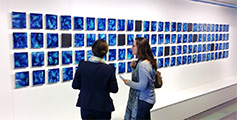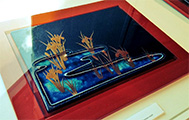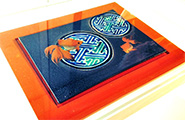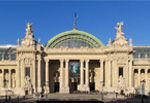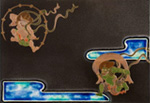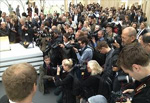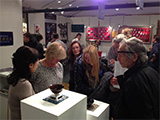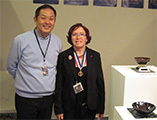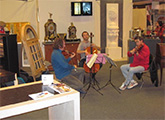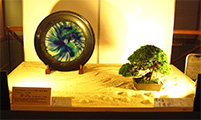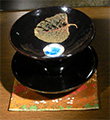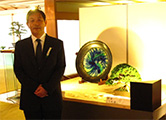

- 16-30 September, 2014
Haruhiko Kaneko Solo Exhibition held at Galerie Le Prés Au 6, Paris
An exhibition of artwork by Haruhiko Kaneko, also known as the founder of Ishigaki-yaki Pottery Studio, was held in the Galerie Le Prés Au 6 in Saint-Germain-des-Prés, in the 7th arrondissement of Paris. The theme of the exhibition was the colour blue, centering around a ‘Happy Blue Wall’. The exhibition, which ran for almost two weeks, kicked off with a well-attended private view on September 16th.
As well as pieces by Haruhiko Kaneko, the exhibition also featured luxury accessories by Masayo Kaneko and collaborative pieces resulting from a creative partnership between Haruhiko Kaneko and Kaga maki-e lacquerware artist Mitsuhiko Takada.
-
-
Article in Cigale mag (L’ART DE VIVRE AU PARISIEN)

Article in the Ryukyu
Shimpo newspaper
Article in the Yaeyama
Mainichi Shimbun
newspaper
- 2-13 September, 2014
Haruhiko Kaneko Exhibition held at Maison de la Culture du Japon à Paris (Japan Foundation).
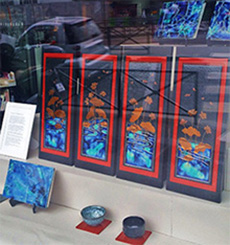
- The opportunity to hold a solo exhibition at this venue is normally only offered to artists and craftspeople who have been designated by the Government of Japan as living national treasures. As such, this was an extremely rare event, comprising a number of stunning exhibits, including the nine-metre wide ‘Happy Blue Wall’, masterful tea bowls, and contemporary pieces. Luxury accessories by Masayo Kaneko and collaborative pieces with Kaga maki-e lacquerware artist Mitsuhiko Takada were also exhibited in the same space, and were the subject of considerable interest among visitors.
Fondation de Japon Paris Japon centre culturel
http://www.mcjp.fr/francais/expositions/haruhiko-kaneko-maitre-de-la/haruhiko-kaneko-maitre-de-la
-
- November 16, 2013
Artworks by Haruhiko Kaneko included in the Kawamura Collection of Shimonoseki City Art Museum
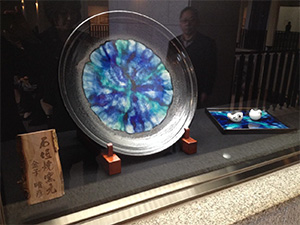
- The Shimonoseki City Art Museum procured two pieces of Ishigaki-yaki pottery for one of its permanent collections: Umi, a large circular plate, and a large square dish, as well as two reproductions of the fukufue, a type of ocarina first launched as a popular product in 1935 by a Shimonoseki City businessman Kojiro Kawamura and intended to be a symbol of the city. However, only a few of these ocarinas, originally known as fugufue, remained, and the instrument was under threat of becoming forever lost. A number of Japanese ceramists had previously attempted to reproduce the fugufue but none had been successful until Haruhiko Kaneko. His reproductions, now renamed fukufue, together with the knowledge required to reproduce the instrument, were bestowed to the City Museum.
Kojiro Kawamura was an entrepreneur born in Shimonoseki City who supported and nurtured many artists. Artists under his patronage included Ryusei Kishida, Ryuzaburo Umehara, Léonard Tsugouharu Foujita, and Yasuo Kazuki, who all worked in the youga or Western style of painting; Hokkai Takashima, who specialised in Japanese style painting; and Yumeji Takehisa, a painter and poet. The pieces by Haruhiko Kaneko, President and founder of the Ishigaki-yaki Pottery Studio, are now part of the Kawamura Collection at the Shimonoseki City Art Museum.
- September 11-15, 2013
Exhibiting at Salon REVELATIONS – GRAND PALAIS, Paris
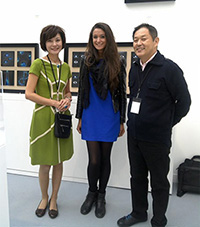
-
Salon RELEVATIONS – GRAND PALAIS was held to great acclaim from 11-15 September, 2014. This was the first Salon RELEVATIONS – GRAND PALAIS to be held in France. The first day was met with long queues and a wait of around one hour to gain entry to this exhibition, and welcomed a number of distinguished guests included members of the Royal Family of Norway. With over 33,000 visitors across five days, the exhibition proved itself to be one of Europe’s finest.
Around 300 artists from 100 companies around the world were selected to participate in the exhibition. Haruhiko Kaneko and Ishigaki-yaki Pottery Studio were chosen to fill one of the limited places (30 companies, 100 artists) for international participants. Haruhiko Kaneko was particularly honoured to be the only artist selected from Japan to be a part of the exhibition.
-
French participants included several Un des Meilleurs Ouvriers de France (MOF, contemporary craftspersons recognised as having outstanding skills) and craftspeople and artists designated as living national treasures. The Ishigaki-yaki Pottery Studio stand welcomed an endless stream of visitors, including many Parisian locals. The Studio was also delighted to welcome Miss France, the winner of Miss International 2012, to the stand.
-
The three-part work, Hokuto Shichisei (The Big Dipper), a multimedia piece combining Kaga maki-e lacquerware, ceramic, glassware, and pearl, was selected to become part of the permanent collection of the Ateliers d’Art de France.
Kaneko’s artwork prompted the interest of the Master Alliance of Ceramic Art in China, which has subsequently exhibited two pieces—one yohen-taihi tenmoku tea bowl with characteristic iridescence and oil-spatter pattern and a yuteki tenmoku tea bowl with a characteristic black glaze—in the Tao Art Gallery in Shanghai, and continued to exhibit the pieces at various shows throughout China until the middle of October 2014.
The exhibition was also the first showcase anywhere in the world of two new collaborative pieces, made with glass, ceramic material, and Kaga maki-e lacquerware: Fujin, Raijin (God of Wind, God of Thunder) and Shunka Shuto (Four Seasons). These pieces have also been shown as part of the subsequent exhibition Kanazawa: Origins of a Samurai Culture, alongside personal items of Toshiie Maeda, one of the most powerful generals to serve under Nobunaga Oda in the sixteenth century.
-
- November 8-11, 2012
Exhibiting at SALON INTERNATIONAL DU PATRIMOINE CULTUREL, Paris
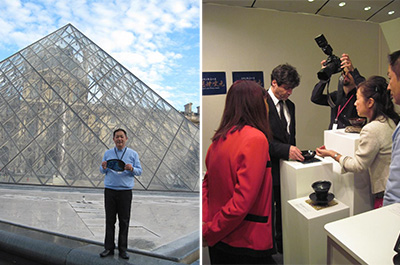
- The SALON INTERNATIONAL DU PATRIMOINE CULTUREL (International Heritage Show) was held in the Carrousel du Louvre in Paris from 8-11 November 2012. The event was a perfect platform on which to showcase yohen-taihi tenmoku tea bowls (with characteristic iridescence and oil-spatter pattern) and hekikai konoha tenmoku tea bowls (a fusion of glass, pottery, and tree leaf). Happily the visitors, who included tourists, collectors, art historians, and wealthy individuals, appeared unanimous in their admiration for Kaneko’s exhibits.
The Carrousel du Louvre is located below the Musée du Louvre and is part of the palace. It is well known for being the location chosen by Chanel to showcase its new collections twice each year.
Participation in the show is by strict selection only; participants in 2012 included a number of Un des Meilleurs Ouvriers de France (MOF, contemporary craftspeople recognised as having outstanding skills), and craftspeople designated as living national treasures. The event is a wonderful opportunity to view outstanding French craftsmanship, including lace, stained glass, and reproductions of 12-13th century ceramic plates.
- 2011-2013
Exhibiting at MAISON & OBJET (Hall 4, Craft) for three consecutive years

- Maison & Objet, held annually in Paris, is one of the world’s most renowned trade fairs. It is said to be the “Paris collection for interior design”, and is considered to be an important gateway to international recognition and success. Only two Japanese companies have exhibited artworks in the Craft hall (Hall 4) for three consecutive years; one of those is Ishigaki-yaki Pottery Studio. The studio has not exhibited since 2013, but the three years Ishigaki-yaki Pottery Studio participated in the event were formative, helping to shape the path which the studio is now taking towards the future.
- September 29, 2010
Exhibiting at World Heritage Site Nikko Tosho-gu
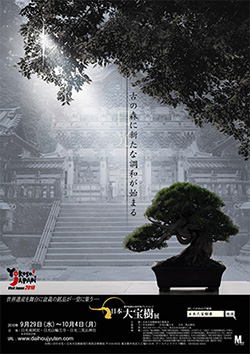
- This rare exhibition celebrated some of the oldest and most valuable bonsai trees in Japan. Many of the bonsai had never been viewable by the general public before, making this a must-see event.
These priceless bonsai were displayed among ceramic art created by living national treasures, with some pieces valued at millions of yen. To the delight of Ishigaki-yaki Pottery Studio, pieces by Haruhiko Kaneko were also selected to be part of the exhibition and were displayed alongside masterpieces by living national treasures. Some of the bonsai were well over 500 years old, still others close to a thousand, yet thanks to the formidable knowledge of the bonsai experts who have cared for the trees over time, none of them is more than one metre in height. Bonsai can encapsulate many things: a cosmic view, a sense of time, and a sense of seasonality. Bonsai owners would only pass their precious trees into the care of someone who shared the same philosophy and beliefs. As such, they are expressions of great and mutual respect over the centuries. The exhibition was held in the Kyakuden Guest Hall, where the Emperor and Empress of Japan have stayed as well as other members of the Imperial Family.
The theme of the event, held in the Tosho-gu World Heritage Site, was “coexistence with nature”. This resonated well with the underlying philosophy behind Ishigaki-yaki, namely to express in our pieces both human happiness and the eternal beauty of the Okinawan seas. This allowed the artist, Haruhiko Kaneko, to realise a world-first collaborative piece between pottery and bonsai. If our water, air, and food become polluted, we will wither and die. Kaneko placed a dish, representing the sea—water—as the ultimate source of all life, and a bonsai, representing the mountains which nurture the air, in a miniature garden, filled it with coral sand, to represent Earth seen from the universe and to communicate a message about how we should treasure our natural environment.
The spatter-type pattern characteristic of yuteki tenmoku can be read as an expression of the multitude of stars in our university, and the sea, covering seven tenths of the surface, is representative of Earth. This piece is intended as an expression of the wish to see the beauty of Earth and her nature, as seen from beyond the stars, remains forever.
In the hekikai konoha tenmoku tea bowl, the leaf is intended to represent the mountains, thereby encapsulating both the mountains and the oceans, as seen from space, within the confines of a delicate tea matcha tea bowl.



















